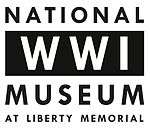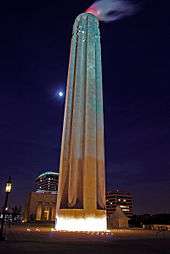National World War I Memorial
|
National WWI Museum and Memorial | |
 | |
| Location | Kansas City, Missouri |
|---|---|
| Coordinates | 39°04′49″N 94°35′10″W / 39.08028°N 94.58611°WCoordinates: 39°04′49″N 94°35′10″W / 39.08028°N 94.58611°W |
| Built | 1926 |
| Architect | Harold Van Buren Magonigle, Westlake Construction Company |
| Architectural style | Beaux Arts Classicism, Egyptian Revival |
| NRHP Reference # | 00001148 |
| Significant dates | |
| Added to NRHP | September 20, 2006[1] |
| Designated NMEM | September 20, 2006[2] |
The Liberty Memorial, located at the National World War I Museum and Memorial in Kansas City, Missouri, USA, is a memorial to service men and women who served in World War I.[3] Fundraising began October 1919 and groundbreaking commenced on November 1, 1921, when the city held a site dedication. The memorial was completed and dedicated on November 11, 1926.[4]
On September 21, 2006, Secretary of the Interior Dirk Kempthorne declared Liberty Memorial a National Historic Landmark.[5] On December 19, 2014, President Barack Obama signed legislation recognizing the Liberty Memorial as a national memorial.[6]
History
The memorial, located within Penn Valley Park, was designed by Harold Van Buren Magonigle who won a national design competition. Several sculptors, including Robert Aitken were involved. The approaches were designed by Wight and Wight.
Liberty Memorial Association
By the time World War I ended on November 11, 1918, many citizens of Kansas and Missouri had lost their lives and a movement to build a monument for their sacrifices and the surviving veterans arose. A group of 40 prominent citizens formed the Liberty Memorial Association and chose lumber baron and philanthropist Robert A. Long, who had personally given a large sum of money, as president.[7] Others included:
- James Madison Kemper was treasurer of the association. For a short time in 1919 he was President of City Center Bank that was founded by his father, William T. Kemper. His brother, Rufus Crosby Kemper Sr., became president when he left to take over as president of Commerce Bancshares, also controlled by his father.
- Jesse Clyde Nichols (J.C.), a real estate developer, was a lead proponent of the Liberty Monument.
- William Volker, businessman and philanthropist, helped the city acquire the land for the memorial.
- George Kessler designed the landscaping at the memorial.[8]

The city council appointed the association to look into the possibility of a monument and funding. In less than a year, the association had spearheaded a fund drive that included 83,000 contributors and collected more than $2.5 million. There would not be the monetary problems that plagued the Bunker Hill Monument.
In attendance at the groundbreaking ceremony on November 1, 1921, were then-Vice President Calvin Coolidge, Lieutenant General Baron Jacques of Belgium, Admiral Earl Beatty of Great Britain, General Armando Diaz of Italy, Marshal Ferdinand Foch of France, and General John Pershing of the United States, along with sixty thousand members of the American Legion; the local veteran chosen to present flags to the commanders was a Kansas City haberdasher, Harry S Truman,[9] who would later serve as President of the United States. The finished monument was dedicated on November 11, 1926, by U.S. President Calvin Coolidge, in the presence of Queen Marie of Romania.[10] In 1935, bas reliefs by Walker Hancock of Jacques, Beatty, Diaz, Foch and Pershing were unveiled.
The Museum and Memorial are managed by a non-profit organization in cooperation with the Kansas City Board of Parks and Recreation Commissioners.[3][11] In 1981, the building underwent a major renovation which updated existing systems to modern code specifications. Another substantial renovation, with a cost estimate of $5 million was undertaken beginning in December 2011.[12] They included $170,000 in energy efficiency upgrades to the building as well as improvements to the artificial flame atop the tower.[13] After several months of dormancy the flame was "relit" on February 1, 2013. Other portions of the overall renovation included security upgrades along with repairs to certain limestone sections and brush removal.[13]
Design
The national design competition was managed by Thomas R. Kimball a former president of the American Institute of Architects (AIA) according to National AIA rules. A disagreement between members of the Kansas City Chapter of AIA and Kimball over the rules, caused almost half of the local members to resign in April 1922. They immediately went on to form the Architectural League of Kansas City, which was merged back into the AIA in the early 1930s. Unlike the AIA at the time, the Architectural League of Kansas City provided membership to less experienced architects and draftsmen and provided social and educational opportunities as well. Regardless of the controversy, many local architects submitted entries including those who resigned from the AIA. The jury, however, was unanimous in their decision to award the contract to New York architect Harold Van Buren Magonigle.[14]
The Liberty Memorial was designed in the classical Egyptian Revival style of architecture with a limestone exterior. The foundation was constructed using sawed granite, and the exterior ground level walls are made of Bedford stone. Further construction occurred in 2000 for expanded National World War I Museum. At night, the top of the 217-foot (66 m) tall memorial tower emits a "flame affect", steam illuminated by bright red and orange lights. This effect creates the illusion of a burning pyre and can be seen for some distance. Overall, the memorial rises 265 feet (81 m) above the surrounding area.
The grounds were designed by George Kessler who rocketed to fame on the strength of his City Beautiful design for the Kansas City park and boulevard system.[15] The road on the west side of the Memorial is Kessler Road.

National World War I Museum

In 2004, the Liberty Memorial Museum was designated by the United States Congress as the National World War I Museum of the United States. The expanded facility opened to the public in December 2006 showcasing the artifact collection that began in 1920. The new subterranean facility was designed by Ralph Appelbaum Associates and greatly expanded the original facilities of Exhibit Hall and Memory Hall, located on the main courtyard.[17] On December 19, 2014, President Barack Obama signed legislation recognizing the Liberty Memorial as a national memorial, which effectively redesignated the Museum as the National World War I Museum and Memorial.[6]
See also
- List of National Historic Landmarks in Missouri
- National Register of Historic Places listings in Jackson County, Missouri: Downtown Kansas City
References

- ↑ National Park Service (2007-01-23). "National Register Information System". National Register of Historic Places. National Park Service.
- ↑ "Liberty Memorial". National Historic Landmark summary listing. National Park Service. Retrieved June 28, 2008.
- 1 2 The National World War One Museum, theworldwar.org.
- ↑ "Liberty Memorial Timeline". TheWorldWar.org.
- ↑ Liberty Memorial Designated Historic Landmark
- 1 2 http://www.kansascity.com/news/local/article4835502.html
- ↑ http://www.kchistory.org/cdm4/item_viewer.php?CISOROOT=/Biographies&CISOPTR=230&CISOBOX=1&REC=19
- ↑ http://www.kclibrary.org/blog/month-kansas-city-history/monumental-undertaking
- ↑ McCullough 1992, p. 150.
- ↑ Donovan, Derek:Marie, Queen of Romania Visits Kansas City's Liberty Memorial
- ↑ "Liberty Memorial Museum: a 'world class' museum in the making: designers of this new WWI museum draw parallels between that war and those of today". VFW Magazine. 2003.
- ↑ "Renovation begins at National World War I museum at Liberty Memorial". KSHB-TV website. December 27, 2011. Retrieved February 2, 2013.
- 1 2 "Flame returns to Liberty Memorial". KCTV-TV website. February 2, 2013. Retrieved February 2, 2013.
- ↑ Ehrlich, George (Autumn 1999). "The Rise and Demise of the Architectural League of Kansas City". Kawsmouth, A Journal of Regional History. 1 (2): 64–73.
- ↑ Liberty Memorial, featured in honor of Veterans Day
- ↑ http://ahr-kc.com/reports/liberty_memorial/
- ↑ National World War I Museum Mission and History
Further reading
- Yost, Mark (November 29, 2006). "Why Kansas City: The Great War Gets an Official Museum of Its Own". The Wall Street Journal. Dow Jones & Company. Archived from the original on May 5, 2008. Retrieved May 23, 2015.
External links
| Wikimedia Commons has media related to National World War I Memorial. |
- Official website
- The National World War I Museum at Liberty Memorial
- Aber, Sarajane Sandusky, "An Architectural History of the Liberty Memorial in Kansas City, Missouri". University of Missouri-Kansas City, 1918-1935.
- Creighton, Neal, (Maj. Gen. U.S. Army retired), "The Liberty Memorial". Association of the U.S. Army, November 2002.
- Myers, Richard B., (General, U.S. Air Force; Chairman of the Joint Chiefs of Staff), "Liberty Memorial Rededication". Kansas City, MO, Saturday, May 25, 2002
- Liberty Memorial Association, "Murals at Liberty Memorial". 1961 (Photos and description of murals adapted to Memory Hall of the Liberty Memorial in the 1940s-1950s; MacMorris, Daniel) [Kansas City Public Library]
- Millstein, Cydney, "Historic American Buildings Survery of Liberty Memorial". Architectural and Historical Research, April 1, 2000.